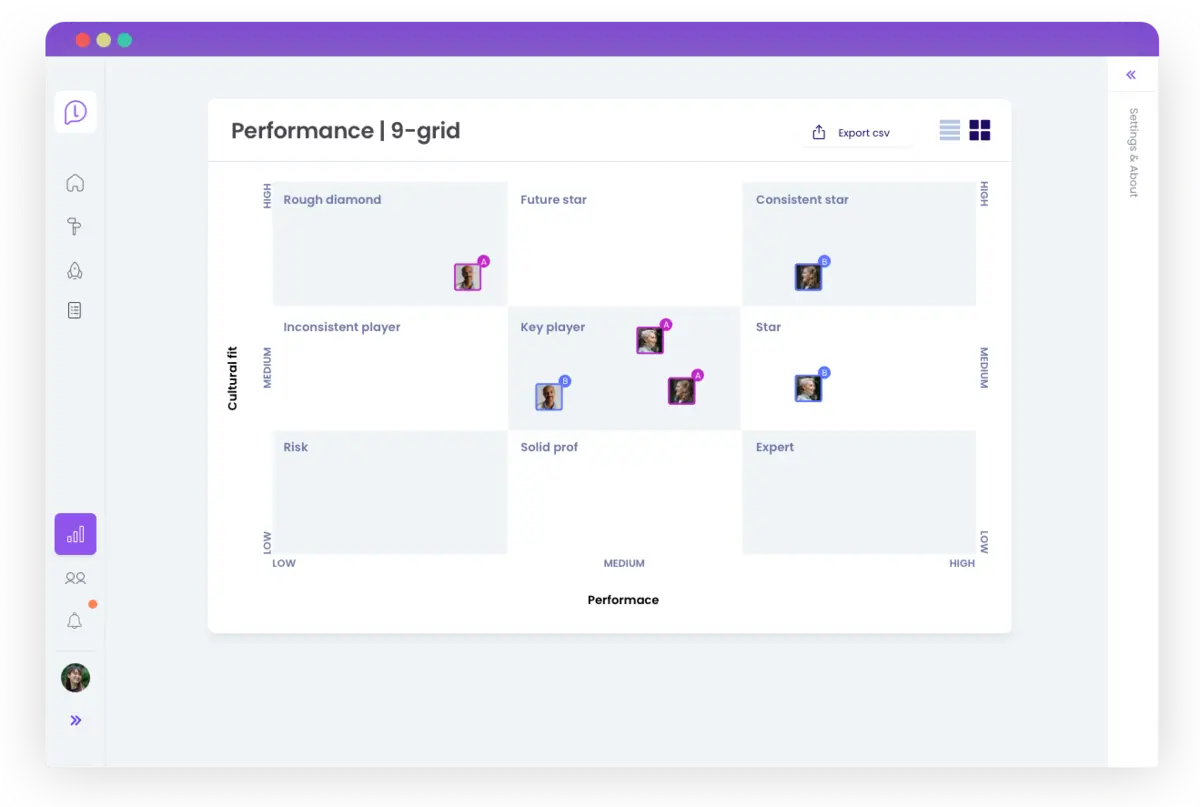In this guide, you’ll read about the growing importance of performance management. For example, you’ll read why simply stopping the interview cycle or appraisal doesn’t work, and we provide 5 tips for a modern performance management cycle based on Learned’s 200 customer implementations. Getting started with performance management right away? Design your own modern HR cycle with our free e-guide. Download it here!
What is Performance Management?
Performance management is the continuous 5-step process. These steps improve the performance of individual employees and teams. Performance management includes planning, monitoring and evaluating performance.
With the goal of improving employee performance, developing talent, increasing engagement and ensuring greater effectiveness. It focuses on both the past and the future and supports employee growth and development. ‘Performance management’ is also called it. In practice, the following are covered:
- Defining goals
- Measuring performance
- Giving feedback
- Developing skills
- Adjusting behavior
Jacco van den Berg
Jacco van den Berg, author of the book “The Performance Menu,” emphasizes that defining, monitoring and directing results agreements and employee behavior in line with the organization’s mission, vision and values is an important part of performance management.
This helps translate the organization’s vision into concrete goals and actions at the individual level. By driving results and behaviors that align with the organization’s mission, vision and values, employees are encouraged to work in line with organizational goals and culture. This helps achieve the strategy and growth of the organization.
Why is this becoming increasingly important?
Performance management can support development opportunities for employees by providing feedback and evaluations on their performance, setting goals and development plans. It can help managers and employees work together to develop skills and knowledge needed for growth and advancement within the organization. In this chapter, we zoom in on 4 key drivers of employee engagement and retention that are influenced by performance management.
1. The importance of development opportunities
Companies that invest in a modern performance management process that pays attention to employee development are likely to have an edge in attracting and retaining talent. There are several indications that employees increasingly value development opportunities when choosing an employer:
- Several surveys show that employees consider the opportunity to learn and grow to be one of the most important aspects of their work. For example, the 2021 Deloitte Human Capital Trends report shows that 25% of employees consider the opportunity to learn and develop as the most important aspect of their work.
- Companies have increasingly invested in training and development as part of their human resources policies. According to the 2021 Training Industry Report, companies worldwide are spending more and more money on training and development, suggesting that companies are aware of employees’ need for development opportunities.
- Employees are also more likely to change jobs if they do not have the opportunity to develop at their current employer. According to LinkedIn Learning’s 2021 Workforce Learning Report, 94% of employees are willing to stay with an employer longer if that employer invests in their development.
All in all, there are increasing signs that employees are focusing on development and growth when choosing their employer.
2. Understanding career prospects
There is a clear relationship between performance management and the internal advancement of employees at an organization. Performance management is the process of assessing employees’ performance and taking action to improve their performance. This process can help identify which employees are suitable for internal advancement and determine their development paths.
There are several indications that internal advancement is becoming increasingly important for employees to continue working at their organizations:
- Research shows that employees who have the opportunity for advancement within their organization are more satisfied and less likely to leave the organization. In fact, according to a study by LinkedIn, employees stay with their company about 41% longer if it regularly hires people internally (LinkedIn, 2020)
- Companies are increasingly focusing on internal flow as a means of retaining talent. For example, Deloitte’s 2021 Human Capital Trends report shows that 45% of organizations had internal mobility as a major focus on their agenda in 2020.
- Employees are eager to increase their skills and knowledge and are therefore looking for new challenges. If their current employer cannot provide these challenges, employees are more likely to look elsewhere for opportunities. However, internal advancement can give them the opportunity to develop their knowledge and skills while remaining within the organization.
In summary, there is growing evidence that internal advancement is important for employees to stay employed at their organizations. Performance management plays an important role in encouraging internal flow.
3. Relationship with manager and frequent feedback
Performance management can have a positive impact on the relationship between the manager and employee through regular communication, feedback and joint goal setting. If done well, the process can improve employee engagement, motivation and professional development and strengthen the relationship between manager and employee.
There are several indications that the importance of a good relationship between employees and their managers is increasing for employees:
- Research shows that employees who have a good relationship with their manager are more engaged, motivated and productive. This can lead to better performance and less turnover (Gallup 2020).
- Managers play an important role in creating a positive work culture and supporting employee development. A good relationship between manager and employee can increase trust and enable open communication (“The Future of Jobs” by the World Economic Forum and Delloitte research)
- With the increased focus on wellness and mental health at work, the importance of a supportive relationship between manager and employee is becoming increasingly apparent. A manager who listens, supports and shows understanding can help reduce stress and burnout.
4. Contributing and making an impact
Performance management can give employees insight into the impact they make within an organization by regularly assessing employee performance. In doing so, managers can indicate which tasks and objectives were done well and where improvement is needed. This gives employees insight into the impact their work has on achieving organizational goals.
In addition, Cascading can be used when creating the employee’s individual goals. Cascading is one way to make this insightful. So you can translate organizational goals into team goals, on which you translate them into employee goals. This way, you challenge employees to set goals that contribute to the goals of the organization. Want to know how to do this? Read more in our blog “Preparing for the planning interview: tips and examples.
Employees who can link their goals to the organization are 3.5 times more engaged with the organization (Gallup, 2019). Indeed, one of the drivers for employees at work is to make an impact. Unfortunately, only 44% of employees experience this connection (Gallup, 2019).
Key trends
There has been much talk in recent years about doing away with the performance review and/or the entire interview cycle and moving away from rewarding employees. In this section, we discuss the main two trends and why simply doing away with the performance appraisal process or stopping appraisal doesn’t work.
Development 1: Moving away from the performance appraisal and mandatory HR cycle
Organizations are moving away from the traditional performance management cycle for several reasons:
- Limited effectiveness: Research shows that traditional performance management methods, such as annual performance reviews, have limited effectiveness in improving performance and supporting employee development. This method often focuses on retrospective assessment and can provide limited insight into future employee performance.
- Lack of flexibility: Traditional methods are often rigid and inflexible, failing to cope with the changing needs of employees and organizations.
- Employee dissatisfaction: Employees are often dissatisfied with the traditional performance management cycle, because the appraisal process is often subjective and does not meet their needs.
- Emergence of new technologies: New technologies such as real-time feedback tools and performance analysis software make it possible to measure and analyze performance in a fast and more automated way, replacing traditional methods.
As a result, organizations often do away with their traditional performance management.
Learned founder Joost Kuijf says the following: Performance Management is sometimes called the V&D of HR. Traditional performance management is out of date. You set goals at the beginning of the year and then evaluate them at the end of the year. “That system dates back to 1920” says Joost Kuijf, one of our co-founders, “back then, for example, an employer gave the goal of packing X number of products, during the industrial revolution, and this was evaluated at the end of the year. That was still very measurable back then.” More and more organizations are coming to the conclusion that this system no longer fits their organization and are stopping the performance appraisal, for example, completely.
Development 2: Stop judging
Organizations stop formally assessing employees because traditional assessment methods have limited effectiveness in improving employee performance and development. One of the main reasons is that employees perceived the traditional assessment, which often consisted of one interview per year with one rating on a five-point scale, as subjective.
Many employees perceive a single rating on a five-point scale as subjective for the following reasons:
-
- It is only a snapshot and does not reflect how the employee has developed over a longer period of time.
- The manager’s sentiment can affect the rating and therefore can be subjective.
- Development and additional work of the employee is often not taken into account.
- It may be unclear to the employee exactly what the assessment is based on, causing the assessment to be perceived as subjective.
Subjective assessment can negatively affect employee motivation because of:
-
- Unfairness: employees may feel they are not judged fairly, which can lead to demotivation and feelings of injustice.
- Uncertainty: if the assessment is subjective, employees may question what the assessment is based on, which can lead to uncertainty about their performance and expectations.
- Lack of control: subjective reviews can make employees feel like they have no control over their performance, which can undermine motivation and reduce commitment to the organization.
- Less focused on development: an assessment that focuses primarily on the past can be less motivating than one that focuses on development and growth in the future. Subjective assessment can reduce the focus on development.
This is also evident from research by organizational psychologist Kilian Wawoe. He found that employees perceived the appraisal interview as unfair, because employees felt that the way it was created was not fair and that it was only partially traceable to actual performance (VU, 2017).
Why quitting the HR cycle and assessing doesn’t work
Development 1: Moving away from the mandatory HR cycle
In the previous chapter, we explained why companies have moved away from a formal HR cycle in recent years. However, more and more companies are coming back from this. 83% of HR managers are currently searching for a solution CEB 2020.
In fact, research shows that doing away with a mandatory HR interview cycle can be problematic for several reasons:
- Lack of structure causing conversations to stop happening. In addition, this also removes the structure for during the conversation. As a result, the calls that do take place are up to 14% lower quality.
- A 6% drop in employee engagement: A mandatory HR interview cycle can be an important way to engage employees in their development and performance. Without this cycle, employees’ engagement in their work can decrease, which can lead to decreased motivation and productivity.
- Less transparency and equity and an 8% drop in employees perceiving the compensation system as fair.A mandatory HR interview cycle provides a level of transparency and equity in how performance is assessed and managed. Without this cycle, performance reviews can be more subjective and less consistent, leading to employee dissatisfaction and unnecessary stress in the workplace.
LinkedIn guide on Performance Management
Josh Bersin, principal and founder of Bersin by Deloitte, points out in a LinkedIn guide on performance management that the motto of “manage your own career here” often means employees manage themselves out of the company.
In line with Josh Bersin’s vision, we Learned have heard many organizations over the past few years say, “With us, the employee is in the lead” He or she can indicate to their manager that they want a conversation. However, it turns out after several years in practice that this methodology has proven to be mainly a paper truth. Except for the few articulate and highly ambitious employees, employees are not quick to request a development interview and ask about possible internal career opportunities, says our co-founder Rick Kuijf.
This does not mean, however, that those needs are not there among employees. Only it turns out that in practice, the delusion of the day, or a less empowered employee result in the employee not making their needs known. If the employee’s need for “something new” then increases, the employee often seeks his happiness in another organization.
Development 2: Stopping assessment
In the wake of returning to a modern form of an HR cycle, we are also seeing more and more companies that are no longer striving to do away with employee appraisal altogether. Despite observing good reasons to scrutinize the assessment methodology, it appears that doing away with it completely was not the solution.
A complete elimination of employee appraisal has several disadvantages, namely:
- No insight into high/low performers: Without some form of assessment, it is difficult to determine which employees are high or low performers and why. This makes it difficult to make targeted investments in employee development and motivation.
- How to reward high performers extra: If there is no appraisal system in place, it can be difficult to reward high performers for their efforts and achievements. If they get the same as other employees, it can reduce their motivation and make it more difficult to retain them.
- File building: Without reviews, there is also less opportunity for employee file building. This can be problematic if, for example, there is dysfunction and no documentation to support it.
- Data for strategic workforce building: Assessments provide valuable data for an organization’s strategic workforce building. Without this information, it can be more difficult to determine and anticipate future staffing needs.
- Lack of direction: A Harvard Business Review study found that 70% of employees surveyed said they would have more confidence in their supervisors if regular feedback and coaching were provided. This suggests that the lack of formal appraisals may lead to a lack of direction and focus among employees.
- Fewer development opportunities: A study by the Society for Human Resource Management (SHRM) found that regular performance reviews can improve employee performance and engagement. Without formal reviews, employees’ development can stagnate, making them less motivated to perform.
- Subjective evaluation: A PsychTests.com survey found that 54% of employees surveyed believed their evaluations were subjective and that this negatively affected their work. Without formal performance reviews, evaluating employee performance can be more subjective and less consistent, which can increase dissatisfaction and stress.
- Reduced transparency: A survey by the Chartered Institute of Personnel and Development (CIPD) found that transparency and honesty were important to employees when assessing their performance. Without formal appraisals, the transparency of performance evaluation can diminish, leaving employees with less confidence in their managers and the organization as a whole.
Despite benefits of improved performance appraisals, studies point to drawbacks such as lower motivation, engagement, focus, development opportunities, subjectivity, and transparency.
Joost Kuijf also indicates that completely abolishing appraisal in performance management is not the right route “it would be better to look at reducing subjectivity in appraisal. For example, with multiple moments of measurement and better substantiation. After all, you need data to map your top performers and substantiate decisions for promotion and salary increases…”
5 Tips for a modern performance management system
In the previous chapters, we considered the main trends in performance management. Thus, it became clear that stopping the mandatory interview cycle and stopping employee appraisals were very important. We used research and real-life examples to explain why we at Learned believe that modernizing the HR cycle and appraisal system is preferable to doing away with it. In this chapter, we will consider five key tips for a modern performance management system.
1. Give minimal structure to conversations
What is a minimum interview cycle?
A minimal HR cycle is a simplified version of the traditional HR process, reducing the number of formal review meetings. The goal is to emphasize continuous feedback and development, supplemented by a minimum number of formal evaluation moments. A minimum HR cycle will include the following elements:
-
- Clear goals and expectations for each employee
- Regular feedback and coaching between the manager and employee
- A minimum number of formal evaluation moments.
What is the benefit of a minimal HR cycle?
A minimal HR cycle can provide benefits for both managers and employees. Providing regular feedback and coaching helps employees improve their performance and grow in their positions. In addition, a minimal HR cycle can promote transparency and communication between the manager and the employee, which can improve the relationship between them.
A minimum number of conversations in the HR cycle can benefit the relationship between the manager and the employee. Through regular feedback and coaching, managers can identify potential problems or obstacles early on and respond accordingly. This can lead to improved employee performance and strengthen the relationship between the manager and the employee.
Moreover, the combination of ongoing feedback and a number of set interview times can reduce the stress and anxiety that employees may experience leading up to the interview. This can improve the relationship between the manager and the employee and lead to higher employee engagement and motivation.
However, by incorporating a minimum number of evaluation moments and conversations, you as HR ensure that every employee is guaranteed a conversation for the sake of his or her development. The fact that each employee is evaluated a minimum number of times per year also ensures that sufficient data is collected for the purpose of strategic workforce planning.
Another advantage is that a minimal HR cycle takes less time and resources than a traditional HR cycle. This allows an organization to work more efficiently and focus more on the core functions of the organization.
In short, a minimal HR cycle can provide benefits to both managers and employees. Reducing the number of formal interviews can lead to a more structured and developmental approach and a better relationship between the manager and the employee.
Continuous conversation cycle with Learned
With Learned, we help clients organize rounds of interviews several times a year. The regular talking points can be supplemented by optional interim 1:1s and ongoing feedback. In this way, you ensure a continuous conversation cycle that is adaptable to the needs of each team and employee.
2. Make objective assessments through data
In chapter three we discussed the importance of objective assessments for employee engagement.To arrive at an objective assessment, two things are important. The number of assessments and the rationale for the assessment.
Increase the number of metrics
The number of reviews can affect both the objectivity of the employee review and employee engagement.
If too few performance reviews occur, it can lead to a lack of clarity and communication between the manager and the employee. This can lead to the employee’s ratings becoming more subjective because the manager is less aware of the employee’s performance during the year. As a result, reviews can be less accurate and we cannot fully recognize and reward employee performance. By working with a quarterly or semi-annual assessment, we increase the number of measuring points and thus increase objectivity.
“We see a lot of companies holding their metrics in November and December. But usually they only look at performance around that time. Anything achieved earlier in the year is hardly named. If you have tools to keep track of employee performance throughout the year, the assessment becomes much more fair.” – Joost
Improve the rationale for assessment
Using concrete assessment criteria can help make employee evaluations more objective. This prevents ratings from being based solely on subjective opinions and observations of the manager. There are several ways to make assessments more objective. Below are the most common:
One of the most commonly used method of establishing concrete assessment criteria is to assess the employee according to his duties and responsibilities in his job profile. A job profile is a description of the duties, responsibilities and qualifications required for a particular position. By using these tasks and responsibilities as an assessment criterion, the manager can evaluate the employee’s performance based on the extent to which he or she has completed his or her tasks and fulfilled responsibilities.
In addition to assessing those responsible, concrete assessment criteria can be established by using SMART goals. SMART stands for Specific, Measurable, Acceptable, Realistic and Time-bound. By setting specific and measurable goals for the employee, you can evaluate performance based on how well they have achieved those goals. This makes the assessment less subjective and gives the employee clear expectations.
Another means of establishing concrete assessment criteria is the use of competencies. Competencies are specific skills, knowledge and behaviors that are important for a particular job. By using competencies as evaluation criteria, the manager can assess employee performance based on specific skills and behaviors important to the job. This can help make assessments less subjective and more focused on concrete performance. Here, it is important to clearly communicate the criteria to employees for clear expectations.
It is also important to regularly review and update the criteria to ensure they remain relevant to the job and the organization.
By extension, concrete assessment criteria can be established based on the behavior a person demonstrates on the company’s core values to be used as an assessment criterion. Core values are the fundamental beliefs and principles that define an organization’s culture. By using behavior that aligns with the company’s core values as an evaluation criterion, the manager can assess the employee’s performance based on how they behave in accordance with the organization’s culture and values.
To use core values as an assessment criterion, it is important that they are relevant to the job and the organization. In addition, it is important for the manager to be able to observe and assess the employee’s behavior based on the core values. CDBy using behaviors aligned with the company’s core values as assessment criteria, we can make employee evaluations even more objective and increase employee commitment to the organization.
An alternative approach to establishing evaluation criteria is to use the employee’s personal development as evaluation criteria. Personal development refers to employees’ growth in knowledge, skills and competencies, which they put to use in their jobs. An employee’s personal development is related to growth in knowledge, skills and competencies. This growth is applied in the performance of their function.
Both the commitment to, for example, set development goals and the development of the relevant competencies and/or knowledge areas for the employee’s position can be considered here.
Using personal development as an assessment criterion allows the manager to measure performance against job growth. This increases engagement because employees can link their goals to organizational goals.
Co-founder of Learned Rick kuijf argues that assessing an employee should not depend on one measurement point and/or just one topic. To make an assessment relevant and objective, Learned advises its clients to use a mix of performance, development and cultural fit assessment criteria.
Learned HR software usage survey – (Q3) 2021.
-
- 8 in 10 users found it easier to prepare and conduct interviews;
- 6 in 10 users make more calls;
- 8 in 10 users find conversations more valuable.
3. Make rewards transparent
More and more organizations are choosing to reward everyone equally because it can help create a more equal and inclusive work culture. Under an equal pay system, all employees receive the same pay for equivalent performance, regardless of gender, age, ethnicity or other personal characteristics. This can help reduce inequality and discrimination in the workplace and create a more fair and equitable work environment.
Another benefit of equal pay is that it can help improve employee motivation and engagement. When everyone receives the same rewards for equivalent performance, it creates a sense of togetherness and teamwork, which can lead to higher productivity and better team collaboration.
However, there are also drawbacks to an equal pay system. Some employees may feel that the organization does not adequately recognize and reward their individual contributions. It can also be more difficult to identify and reward high performers. This can lead to less motivation to improve their performance. Another disadvantage of equal pay is that it does not take into account an employee’s stage in their career. For example, an employee at the beginning of his career may experience much greater development than an employee who has been in a particular position for some time.
To avoid these drawbacks, organizations may choose to combine an equal pay system with other forms of remuneration, such as performance pay or individual bonuses. In this way, employees can still be rewarded individually for exceptional performance, while the overall remuneration policy remains equivalent.
Here are three tips for making rewards in an organization transparent, yet rewarding high performers extra:
- Make the performance indicators (KPIs) used to determine rewards transparent and measurable. This allows each employee to see what goals he or she must achieve to earn a particular reward. This creates more transparency and honesty within the organization.
- Make the pay structure more flexible so that there is more room to reward high performers extra. For example, by adding a variable compensation component dependent on individual performance or through bonuses. This allows employees who contribute more to the organization to be rewarded more.
- Make learning agility and the stage of the employee’s career part of the compensation structure. In this way, you create space to reward and retain talented employees who develop.
In addition, it is important to point out that rewards need not consist only of financial compensation. In fact, rewards can include recognition, promotion or other forms of non-financial rewards. So it is important to strike a balance between rewarding high performers and keeping the pay structure transparent.
Another aspect to consider in the pay structure and a hot topic since 2022 is the inflation adjustment.
Inflation adjustment is the adjustment of wages and salaries to account for inflation. This means adjusting wages and salaries to reflect the rising cost of living. It is important to include inflation adjustment in your compensation structure to ensure that the value of compensation is not diminished by inflation.
There are several ways to incorporate inflation adjustment into your compensation structure:
- Indexation: The most common method of inflation adjustment is by indexing salaries and wages. This involves adjusting salaries and wages based on a certain index. For example, the consumer price index (CPI). This means that the salary or wage is adjusted annually for inflation.
- Fixed annual increase: Another way to apply inflation adjustment is through a fixed annual increase in salary or wages. This increase may be based, for example, on the previous year’s inflation rate.
It is important to communicate transparently how inflation adjustment is applied in the pay structure to ensure that employees understand how their salary or wage is adjusted for inflation.
Reward scales with Learned
With Learned, you easily translate evaluations into reward scales. Thus, depending on an overall score, based on the employee’s performance, the employee’s fit with the culture and the employee’s development, you can scale the employee into a performance scale. Based on the performance scale, you can assign pay in a transparent manner.
4. Connect performance management with L&D and internal mobility
Performance management, L&D (Learning & Development), and internal flow within organizations are often separated by different departments managing these processes. Performance management typically assesses employees, sets goals and expectations, but typically does not include the development opportunities required for goal achievement.
However, combining these processes can lead to a more holistic approach to talent management and employee development. Connect performance management, L&D and internal flow to foster a culture of continuous improvement and development within the organization. Employees are hereby supported to improve their performance and achieve their goals.
Partly because of this, HR is also increasingly referred to as Human development. Increasingly, the various departments must work together. Data sharing across departments ensures higher performance, improved development and ultimately more engaged employees.
Development plan and career path with Learned
At Learned, we use measurements in development conversations for employee competencies and skills. These measurements serve as input into the employee’s development plan and career path.
5. Measure the engagement of your high performers on an ongoing basis
Losing high performers can be a nightmare for organizations. This, of course, is because they are often the most talented, motivated and productive employees. They are often key figures in the organization and make important contributions to its success.
When high performers leave, it can lead to many problems. Namely, a loss of expertise and knowledge, which can lead to lost productivity, delays and errors. This can negatively affect the organization’s performance and ability to gain competitive advantage.
It is therefore very important to use performance management to identify who your high performers are. However, it does not stop there. We advise our clients to connect their performance management process with ongoing measurement of employee engagement.
Measuring employee engagement on an ongoing basis is important because engagement is a key indicator of employee retention. Steer continuously for engagement with your high performers to avoid surprises upon their departure.
Ongoing measurement of engagement can additionally help understand the reasons behind engagement or lack thereof. This can lead to the identification of potential areas for improvement. It enables organizations to develop and implement appropriate strategies and initiatives to improve employee engagement and motivation.
Moreover, measuring employee engagement can help organizations identify and understand trends and patterns. This allows them to proactively respond to potential problems before they develop into serious problems. This can help the organization retain their high performers and improve productivity and performance.
Performance management module in Learned
Learned’s performance module makes it easy to measure the performance of your team members. This gets you to base evaluations on real-time data and provides informed feedback. Download now the e-guide: ‘map low and high performers with objective evaluations’.

With the Learned platform, you get the insights you really need. Namely, with which high performer you need to start the conversation to keep them engaged with your organization.


























